FIG 5.

General model of the S105 hole formation pathway. A top-down view of a region of the cytoplasmic membrane is shown; each circle represents a helical TMD. At least four steps, described in the text, are required for hole formation: first, stable dimerization of λ S; second, oligomerization; third, raft formation and helical-face rearrangements; fourth, TMD1 and TMD3 lining the lumen of the hole. The three TMDs (green, TMD2; sectored, TMD1 and TMD3) in a single S molecule are outlined. TMD1 and TMD3 contain two interacting faces, hydrophilic (the face that is also accessible to IASD) and hydrophobic, represented by blue and orange, respectively.
